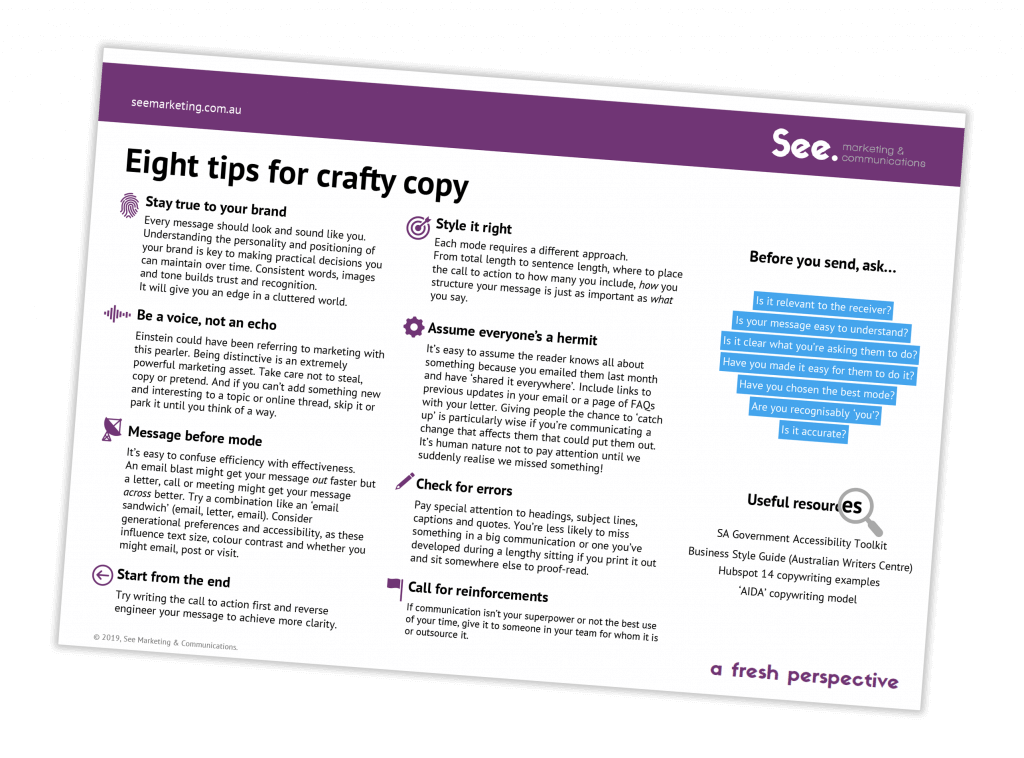
Getting our financial ducks in a row is something we automatically think of when preparing a business for sale – but what about your marketing?
A strong brand and marketing approach can contribute to the value of your business. In 2017, Sustainability Accounting Standards Board Foundation analyst David Post told Forbes that the contribution of intangible assets such as brand in the value of some listed companies can be as high as 80%.
In a time where technology makes it easier for others to imitate our products, intangible assets such leadership capability, organisational culture, customer service approach and brand strength deserve a greater share of our attention.
These are our top tips – and added bonus tip – on how to sharpen your marketing credentials before you put your business up for sale.
1. Update your website
Prospective buyers will likely head here first so it’s important to make sure it’s up to date and everything works, including links and contact forms.
If the last news story or post on your website harks back more than a few months, it’s a good idea to update it. Scan for information that dates your site too, including the year stamp in the footer and staff names and bios that need to be removed or added.
Tip: If you’re not a writer, you can outsource to a business like us quite cost-effectively. A story a month is a reasonable aim for most business and you can share it through your other communication channels too.
2. Spruce up or secure your socials
You might have decided not to use social media in your business but the next owner might see it differently! By securing a profile using your brand name on key social media platforms (including LinkedIn, Facebook and Instagram), you are protecting it for possible use by your future buyer. In most cases, you can claim a profile without having to be active on the platform.
If you have a social media presence now, make sure you are posting good content regularly and responding to messages and comments. Consider including a schedule of future content in your sale pack if you have a strong social media focus – it could help a potential buyer who is less developed in this area to feel more able to transition into the business.
Tip: Consider boosting your social presence if you think buyers will expect it to be more compelling. Do this well in advance of sale as building a profile takes time. Get help if you lack the resources or know-how internally.
3. Clean up your database
The quality and size of your customer and contact database can have a significant bearing on your sale price. But the best database in the world is only as good as the data it holds.
With the passage of time and when we inevitably get busy, it can be easy to put off or forget to update records in our database. That’s why it can be helpful to factor in some time to review your database and bring it up to date if needed before you’re ready to sell.
Tip: If your contacts are scattered across spreadsheets, phones and email systems like Outlook, consider creating a central database. There are many options including Hubspot which you can set up for free.
4. Seek broader inputs
Chances are, you’re planning to involve your accountant in your planning. The financials are important but a wise buyer will also want to see beyond the balance sheet.
Your first challenge is to get potential buyers excited by the potential of your business.
We recently helped a client with an overview document for a business preparing for a sale. In painting a picture of the nature and impact of culture, values, key personnel and marketing strategy, the eventual buyer was able to easily see the promise the business held with them at the helm.
Tip: When preparing your business overview document, brainstorm intangible assets and dedicate a page to each. Include enough text to be informative but not so much that it could overwhelm. Graphs, icons, quotes and infograms will help make your information easy to digest and more visually appealing.
5. Map your marketing and metrics
Not everyone has a formal marketing plan but a buyer is likely to want to see something on paper. You don’t need a 20-page document. A one-page marketing plan or just a summary of key strategies and results over the past 12 months can help a buyer understand the trajectory of the business and think about the opportunities and investment required for future growth.
Tip: If you produce monthly reports for a management group or Board, you already have the data you need to provide a useful snapshot for potential buyers.
6. Play it cool
While some work to plug gaps and tidy up can fly under the radar, a sudden increase in activity could alert staff to the possibility that something is going on behind the scenes. It’s important to keep behaving normally and be clear on how you will answer any questions about the future should an employee confront you with a direct question.
Tip: If you want to keep suspicion at bay, start preparations well in advance so you can avoid doing everything at once.
Bonus tip: Secure your trademark
Owning trademarks for your brand name and logo will send a message to your buyer that their interests will be protected from the outset. The good news is that it’s surprisingly easy and cheap to do and many businesses will be able to do it themselves (we did).
For less than $500 (or less than $1000 if you take out insurance to defend objections by third parties in court) you could have your business name trademarked with just a few hours of your time. Visit IP Australia to learn more.
Tip: Be aware that the actual process takes 8 months because of the legal requirement to publish trademark applications in relevant journals. If your business is complex or you believe there may be objections to your trademark, you should consider if you need to take out insurance or enlist a professional to help.
If you’d like to learn more about how we can help you put your best foot forward when preparing your business for sale, contact us.



